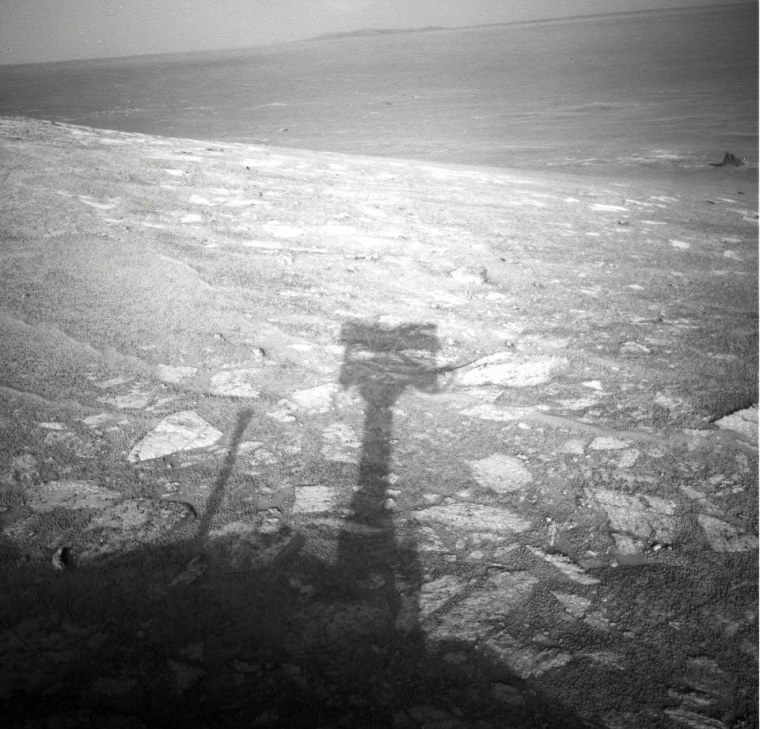While NASA's Spirit rover is frozen in place on Mars and potentially dead to the world, the Opportunity rover is hale and hearty as it begins its eighth year of operation on the Red Planet.
"Seven years is a long time, but we're all delighting in it," John Callas, project manager for the rover missions at NASA's Jet Propulsion Laboratory, told me today.
When Spirit and Opportunity bounced to their airbag-cushioned landings on Mars, back in 2004, the $800 million twin missions were supposed to last only 90 days.
Now both probes have hit their seventh anniversary (Jan. 3 for Spirit, Jan. 24 for Opportunity, both dates according to Pacific time at JPL). Because of their longevity, the rovers look like the one of the best deals going when it comes to interplanetary exploration. Callas estimates that the current spending rate for a two-rover operation is about $17 million a year. The cumulative cost of keeping Spirit and Opportunity going for seven years has been about $900 million, or "about 1 percent of the AIG bailout," Callas joked.

From the beginning, success has come more easily for Oppy than it has for Spirit. Cornell astronomer Steve Squyres, the head of the rover science team, has referred to Opportunity as "Little Miss Perfect." Except for a nagging problem with the rover's mini-thermal emission spectrometer, Opportunity is running just fine with nary a service call.
Opportunity is currently sitting at the rim of Santa Maria Crater in Mars' Meridiani Planum region and will be out of communication for about two and a half weeks, due to Mars' position relative to the sun and Earth. Because of the solar conjunction, communication between Mars and Earth is disrupted by interference. Thus, the rovers as well as NASA's Mars Odyssey and Mars Reconnaissance Orbiter will be put on autopilot until the communication links clear up again.

That doesn't mean Oppy is getting the time off, however. Callas said Opportunity has been programmed to set its Mossbauer spectrometer down on a patch of hydrated sulfate minerals and "integrate for a good long time." Hydrated sulfate deposits are considered an indicator that water once flowed through the area — and so Opportunity's work over the break could set the stage for a fresh round of discovery.
After studying the terrain around Santa Maria Crater, Opportunity will continue its southward odyssey. "We're pretty much going to pull up stakes and head for Endeavour Crater, 6 kilometers away as the crow flies," Callas said. Getting to the crater could take another Martian year — or almost two years of Earth time. It could take even longer, depending on how many stops the science team wants to make along the way.
The 13.7-mile-wide Endeavour Crater would rank as Opportunity's most impressive vista, and the destination with the most potential scientific value. The crater would reveal Mars' geological layers to a phenomenal depth, serving as a time machine for scientists trying to reconstruct the Red Planet's history. Mission scientists are particularly interested in studying the phyllosilicate clay minerals that have been detected from orbit. Such minerals are thought to have formed under wet, warm, non-acidic conditions — just the kinds of conditions that might have been favorable for life.
Spirit still silent
Meanwhile, Callas and his colleagues are still hoping Spirit can be brought back to life as well. Right now the rover is stuck in a sandtrap on the other side of the planet, and mission managers haven't heard from it since last March. The rover team is hoping that the solar-powered Spirit weathered the Martian winter and will build up enough power to come out of hibernation and re-establish contact. But there's always the chance that Spirit has given up the ghost.
"We're probably moving into the regime that, if there's something wrong with the rover, it's probably more than one thing," Callas said. Mission managers are trying a variety of strategies that should get through to Spirit even if there were multiple failures.
How long will NASA keep trying? "It'll be more driven by us exhausting all the reasonable things to try," Callas said. "We're still developing that list. ... Longer-term, we can continue to listen for Spirit at a reduced level of activity for an extended period of time, at minimal cost to the mission."
Even though he's keeping hope alive, Callas recognizes that time is running out. Plans and budgets are already being drawn up for a one-rover operating mode.
"Candidly, it's likely to start rolling off after the March-April time frame," Callas said.
In honor of Opportunity's anniversary and the latest stereo image of the Red Planet, we sent free 3-D glasses to some of the folks who "like" the Cosmic Log's Facebook page. Hit the "like" button on Facebook to get ready for next month's 3-D glasses giveaway. You can also join the Cosmic Log community by following b0yle on Twitter. To learn more about Alan Boyle's book about Pluto and the search for planets, check out the website for "The Case for Pluto."
